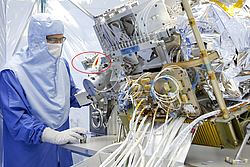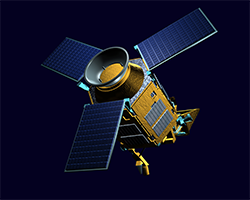In 2012, nanoplus lasers were onboard the Curiosity Mars Rover, as well as on the TROPOMI satellite in 2017. TROPOMI…
Nanoplus travelled to space!
After the launch of the Mars Rover in November 2011, nanoplus lasers are again part of a prestigious space project. This time, their lasers are on board the TROPOMI (Tropospheric Monitoring Instrument) which is the single payload of the Copernicus Sentinel-5 Precursor satellite.
We are excited to work with an organisation which is part of this important mission on monitoring air quality around the globe. According to the project motto “Observing our future”, we will follow Tropomi’s results with great interest.
Observing our future – TROPOMI
TROPOMI will monitor air quality around the earth to cater the scientific and operational community, which is involved in climate and weather. The data it collects will help to refine e. g. air quality forecasts, environmental hazard and UV warnings as well as operational weather forecasts. A further major objective of the mission is to better evaluate the impact of trace gas emissions on climate change.
On a daily basis, Tropomi will quantify the principal tropospheric pollutants: O3, NO2, CO, HCHO and SO2. At the same time, it will measure the two main greenhouse gases, tropospheric O3 and CH4. Various parameters of aerosols will equally be examined, as they influence climate change and pollution of the troposphere.
According to ESA TROPOMI is a “space-borne, nadir-viewing, imaging spectrometer sensing ultraviolet (UV), visible (VIS), near (NIR) and short-wavelength infrared (SWIR)”. With passive remote sensing techniques TROPOMI determines at the top of atmosphere the solar radiation reflected by and radiated from earth.
The Copernicus satellite pioneers a series of atmospheric composition Sentinels and has started on a mission of seven years. It is a joint project of Airbus Defence and Space, KNMI (The Royal Netherlands Meteorological Institute), SRON (Netherlands Institute for Space Research) and TNO (The Netherlands Organisation for applied scientific research). The space mission was assigned by NSO (Netherlands Space Office) and ESA (European Space Agency).


Article sourced from our partner: nanoplus
Other Blogs/Articles that may be of interest:
- Why is Mid-IR Light so Important?
- Engineered Point Spread Functions (PSF) for Single Molecule Localisation Microscopy (SMLM)
- Nanoscopy for less than £100k?
- Understanding the jargon of LCOS Spatial Light Modulators (SLMs)
- Spatial Light Modulator Applications
To book a demonstration or loan of a nanoplus laser and to speak to one of our engineers here:






























